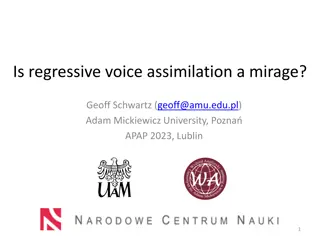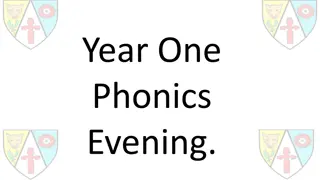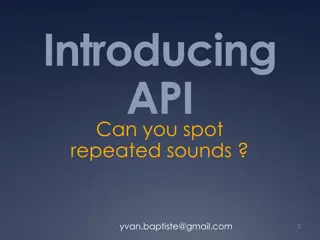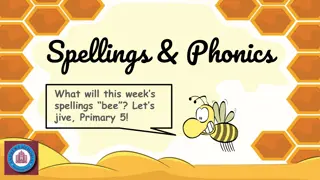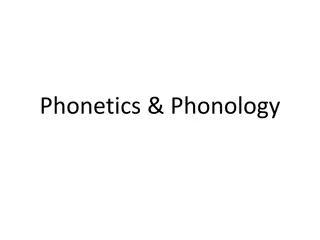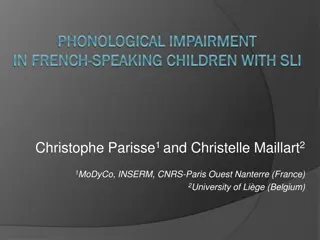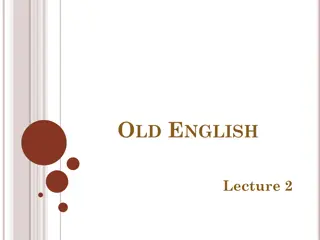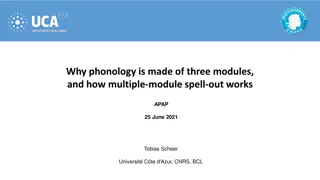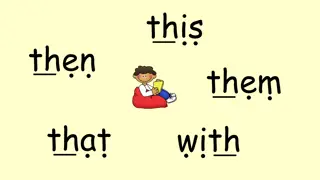
Understanding Distinctive Features of English Phonemes
Delve into the world of English phonemes and learn about distinctive features that define classes of sounds relevant to phonology. Explore the history, function, and natural classes of distinctive features proposed by Roman Jakobson. Understand how these cognitive properties shape the contrasts between speech sounds and determine sound sets in language.
Download Presentation

Please find below an Image/Link to download the presentation.
The content on the website is provided AS IS for your information and personal use only. It may not be sold, licensed, or shared on other websites without obtaining consent from the author. If you encounter any issues during the download, it is possible that the publisher has removed the file from their server.
You are allowed to download the files provided on this website for personal or commercial use, subject to the condition that they are used lawfully. All files are the property of their respective owners.
The content on the website is provided AS IS for your information and personal use only. It may not be sold, licensed, or shared on other websites without obtaining consent from the author.
E N D
Presentation Transcript
* PEOPLE S DEMOCRATIC REPUBLIC OF ALGERIA Ministry of Higher Education and Scientific Research University of Ben Boulaid Moustafa, Batna-2 Algeria Faculty of Letters and Foreign Languages Department of English Second Year Phonetic Courses TEACHER. Mrs.RAHMANI. A Academic year 2020-2021
Course Three: Distinctive Features of English Phonemes History of Distinctive Features The Function of Distinctive Features Natural Classes of Distinctive Features Major Class Features Place features TONGUE Body Features Manner of Articulation Features Laryngeal Features
Distinctive features Roman Jakobson proposed that there is one universal set of distinctive features for all languages, which define classes of sounds relevant to phonology. All contrasts must be stated in terms of these features. All restrictions on distribution must be stated in terms of these features.
Definition * Distinctive features are the universal set of cognitive properties associated with the speech sounds that are used in language. * They determine the contrasts which may exist between speech sounds, account for the ways in which these sounds may change, or alternate, and define the sets of sounds.
Feature Systems The formal development of distinctive feature theory is due primarily to Roman Jakobson. *a) Only binary oppositions are accepted.[+/-] *b) Descriptions should be based on a minimum number of DFs. *c) These are selected from a limited set of universal DFs. *d) The DF values for the sounds of a language are arranged as a matrix with +, and 0 (not relevant) values.
*Major Class Features The major class features are: [consonantal] +obstruent; -vowels, glides [sonorant] [syllabic] +vowels; -consonants They define major classes of sounds, such as consonant and vowel, sonorant and obstruent.
Laryngeal Features The laryngeal features are: [voice] [spread glottis] +aspirated; - unaspirated [constricted glottis] +glottal; - glottal They define glottal state of sounds thus classifying into voiced and voiceless, aspirated and unaspirated.
Place Features The place features are: [Labial] +bilabial, labiodental [Coronal] +dental, alveolar [Dorsal] +palatal, velar They specify the place of articulation.
Manner Features: The manner features are: [Continuant] +no obstruction [Nasal] +velum lowered [Lateral] +laterals [Delayed release] +affricates; - stops They specify the manner of articulation.
*Some consonant classes [son] _ _ _ + [cont] _ _ + _ + [del rel] _ + + _ -` PLOSIVES Affricates - - Fricatives Nasals - Approximant +
Height Features [high]: A sound is [+high] if it is produced with the tongue body raised from neutral (mid central) position; otherwise it is [-high]. [low]: A sound is [+low] if it is produced with the tongue body lowered from neutral (mid central) position; otherwise it is [-low].
Back Features: [back]: A sound is [+back] if it is produced with the tongue is positioned far back as possible in the mouth without creating a constriction that would be classified as a consonant; otherwise it is [- back].
History of Distinctive Features Three main approaches that influenced the definition of distinctive features,: 1/ Distinctive Oppositions 1939(Nikolai Trubeztkoy ) 2/Acoustic Features1950 s( Jacobson Roman ) 3/ The SPE Approach 1968( Chomsky Noahm/ Morris Halle)
Distinctive Oppositions 1939(Nikolai Trubeztkoy ): TAXONOMY OF CONTRASTS that encomapsses the following: Opppoitions withing the sysytem Oppositional Relations Types Of Oppostional Extents . 2/Acoustic Features1950 s( Jacobson Roman ): Concept of binarity(two values /+) Accoustic features(due to sonograph) he introduced the following features: Major Class features. Features for vowels Features for consonants Secondary articulation features.
The SPE Approach 1968( Chomsky Noahm/ Morris Halle) MAJOR CLASS FEATURES PRIMARY PLACEMENT FEATURES ADDITIONAL FEATURES.
*Major Features 1. Sonorant: these have spontaneous voicing. E.g. vowels, approximants, nasals 2. Non-sonorant: also called obstruents. spontaneous voicing not possible. They have both voiced and non-voiced elements. Plosives, fricatives, affricates 3. Vocalic: In producing them, no obstruction at any point. Eg, vowels, semi-vowels /r, l/ 4. Non-vocalic: there is obstruction in the production process. Eg, nasals consonants, non-sonorants, 5. Consonantal: There is obstruction at some points in the vocal tract, as narrow as in fricatives and approximants. 6. Non-consonantal: No obstruction is possible in their production. Eg, vowels
*Cavity Features : 1.Anterior: these sounds are produced with obstructions in front of the palato- alveolar region. Eg, labials, dentals, alveolars. 2.Non-anterior: The sounds are made before the alveolar region. Eg, palato- alveolar, velar, glottal, 3.CORONAL : blade of the tongue is raised upwards from its neutral position. Eg, dentals, alveolar, palato-alveolar. 4.Non-coronal: the blade of the tongue is not raised above the neutral position. Eg, labials, palatal, velar, vowels. Neutral position is the /e/ position.
Tongue Features: 1. High: when the tongue is raised above the neutral position. Eg, palatals, velars, high (close) vowels 2. Non-high: when the tongue is not above the neutral position. Eg, labials, glottal, central and low (open) vowels 3. Low: the tongue is below the neutral position. Eg, low (open) vowel /a:/, glottal /h/, 4. Non-low: when the tongue is not lowered below the neutral position. Central and high vowels, labials, alveolars, palatals, velars 5. Back: Tongue is retracted backwards from the neutral position. Eg, velars, back vowels, etc. 6. Non-back: when there is no retraction of the tongue. Sounds in front of the velar. Eg, labials, dentals, alveolars, palatals, central and front vowels
*Lip Posture: 1. Round: when the lips get rounded and narrows the lip orifice. Eg, back vowels, velar approximant /w/ as well as labialised sounds. 2. Non-round: such rounding does not occur. Eg, all front, central and low (open) back vowels, coronals, palatals, alveolars, and non-labialised velars. Secondary Aperture Features: 1. Nasal: velum is lowered to allow airstream pass through the nose. 2. Non-nasal: velum is not lowered for its production. Oral articulation of sounds. All oral sounds are produced in this manner.
Manner Features: 1.Continuant: there is no total blockage of air at the point of articulation. Eg, fricatives, approximants 2.Non-continuant: there is blockage of airflow at some point in the constriction of the articulatory organs. Eg, plosives and affricates 3.Delayed release: the air is gradually released after its obstruction. Eg, affricates /t , d / 4.Non-delayed release: obstructed air is released instantaneously. Eg, plosives.
*Phonation Features 1.Voiced: there is the vibration of the vocal cords in its production. Eg, all English vowels, voiced consonants in English 2.Non-voiced: there is free passage of air through the glottis. Eg, voiceless consonants, devoiced vowels and consonants Note: remember that DFs are phonological features. So, such devoiced consonants and vowels can occur due to environmental conditioning. You will learn about this in the phonological processes


